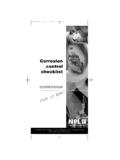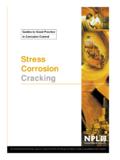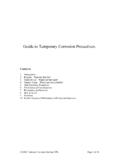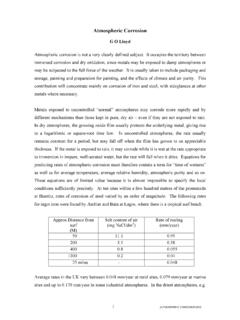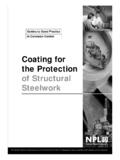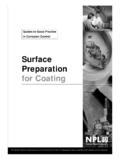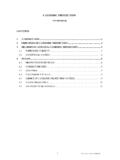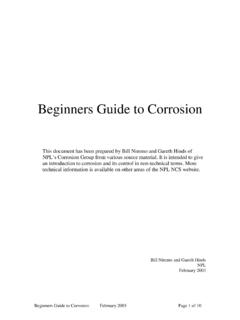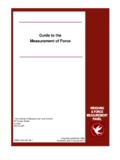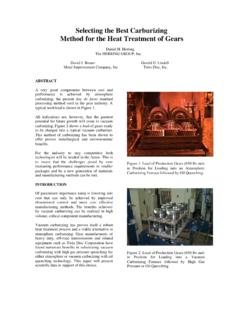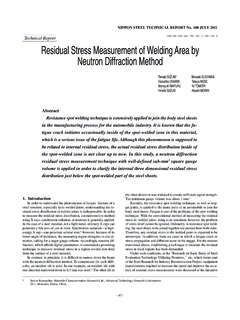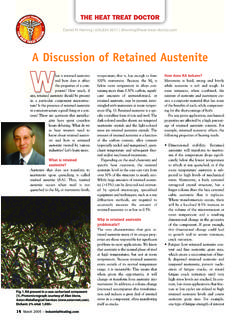Transcription of Determination of Residual Stresses by X-ray …
1 A NATIONAL MEASUREMENTGOOD PRACTICE GUIDED etermination of Residual Stresses by X-ray diffraction - Issue 2No. 52 The DTI drives our ambition of prosperity for all by working tocreate the best environment forbusiness success in the help people and companiesbecome more productive bypromoting enterprise, innovationand champion UK business at homeand abroad. We invest heavily inworld-class science and protect the rights of workingpeople and consumers. And westand up for fair and open marketsin the UK, Europe and the Guide was developed by the NationalPhysical Laboratory on behalf of the NMS. Measurement Good Practice Guide No. 52 Determination of Residual Stresses by X-ray diffraction Issue 2 Fitzpatrick1, Fry2, P. Holdway3, Kandil2, J. Shackleton4 and L. Suominen5 1 Open University, 2 National Physical Laboratory, 3 QinetiQ, 4 Manchester Materials Science Centre, 5 Stresstech Oy Abstract: This Guide is applicable to X-ray stress measurements on crystalline materials.
2 There is currently no published standard for the measurement of Residual stress by XRD. This Guide has been developed therefore as a source of information and advice on the technique. It is based on results from three UK inter-comparison exercises, detailed parameter investigations and discussions and input from XRD experts. The information is presented in separate sections which discuss the fundamental background of X-ray diffraction techniques, the different types of equipment that can be used, practical issues relating to the specimen, the measurement procedure itself and recommendations on how and what to record and report. The appendices provide further information on uncertainty evaluation and some recommendations regarding the data analysis techniques that are available.
3 Where appropriate key points are highlighted in the text and summarised at the end of the document. This second issue includes a new section on depth profiling, additional examples of uncertainty evaluation and recommendations regarding X-ray elastic constants and data presentation. Measurement Good Practice Guide No. 52 Crown copyright 2005 Reproduced with the permission of the Controller of HMSO and the Queen's Printer for Scotland ISSN 1744-3911 September 2005 National Physical Laboratory Teddington, Middlesex, United Kingdom, TW11 0LW Website: Extracts from this report may be reproduced provided the source is acknowledged and the extract is not taken out of context. Acknowledgements This Guide has been produced as a deliverable in a Measurements for Processability and Performance of Materials project on the measurement of Residual stress in components.
4 The MPP programme was sponsored by the Engineering Industries Directorate of the Department of Trade and Industry. The advice and guidance from the programme s Industrial Advisory Group and XRD Focus Group are gratefully acknowledged. The authors would like to acknowledge important contributions to this work from Jerry Lord, the enthusiasm of the XRD Focus Group established for this project and all participants of the XRD Round Robin exercises. For further information on X-ray diffraction or Materials Measurement contact Tony Fry or the Materials Enquiry Point at the National Physical Laboratory: Tony Fry Materials Enquiry Point Tel: 020 8943 6220 Tel: 020 8943 6701 Fax: 020 8943 6772 Fax: 020 8943 7160 E-mail: E-mail: Measurement Good Practice Guide No.
5 52 Contents 1 Introduction .. 1 2 Scope .. 1 3 Definitions .. 2 4 Symbols .. 4 5 5 Bragg s Law ..5 Strain Measurement .. 6 Stress Determination .. 8 Depth of 10 6 12 General .. 12 diffraction 13 Positive and Negative Psi Offsets .. 17 Major Components of Lab Based Stress Diffractometers .. 18 The X-ray Tube .. 19 The Primary 20 Secondary Optics .. 24 25 Portable Systems .. 27 Primary Optics .. 28 Secondary Optics .. 28 Sample Positioning .. 28 7 Radiation 29 Sample Fluorescence .. 29 diffraction Angle, 2-Theta .. 29 Choice of Crystallographic Plane .. 30 8 Specimen Issues .. 31 Initial Sample Preparation .. 31 Sample 32 Grain Size .. 32 Sample Size/Shape.
6 32 Surface Roughness .. 33 Coated Samples .. 34 9 XRD Depth Profiling Using Successive Material Removal .. 35 Material Removal Technique .. 35 Electro Polishing Theory .. 35 Electro Polishing Problems .. 37 Data Correction .. 38 Flat Plate .. 38 Hollow 39 Measurement Good Practice Guide No. 52 Measurement and Data Presentation .. 40 Measurement of the New Surface Position .. 40 10 Measurement Procedure .. 42 Positioning of the Sample .. 42 Goniometer 42 Sample Height and Beam Alignment .. 42 Calibration Using a Standard 43 Measurement Directions .. 43 Theoretical 43 Principal Stress Directions .. 43 The Full Stress Tensor .. 44 Measurement Parameters .. 44 X-ray Tube 44 Measurement Counting Time and Step Size.
7 44 Number of Tilt Angles Required for Stress Determination .. 45 Dealing with Non-Standard Samples .. 46 Large-Grained 46 Highly-Textured Materials .. 47 Multiphase 47 Coated Samples .. 47 Materials with Large Stress Gradients .. 47 Data Analysis and Calculation of 47 Errors and Uncertainty .. 48 11 Reporting of Results .. 48 Value of Residual Stress .. 49 Uncertainty .. 49 Stress Direction .. 49 Depth Position .. 49 diffraction 49 X-ray Wavelength .. 49 diffraction 49 K- Filtering .. 50 Optical Set-up .. 50 Position of the 50 Additional Recording Parameters .. 50 Fitting Routine .. 50 Material Properties .. 51 Surface Preparation Method .. 51 Machine 51 Sample Details .. 51 Other .. 51 12 53 References .. 55 Appendix 1 .. 56 Sources of Measurement Uncertainty.
8 56 Introduction .. 56 Sources of Uncertainty in Residual Stress Measurement .. 56 Evaluation of Uncertainty in the Measurement .. 57 Symbols and Definitions for Uncertainty Evaluation .. 58 Numerical Examples .. 59 Surface Residual Stress Measurement .. 59 Residual Stress with Respect to Depth Measurement .. 60 Appendix 64 Measurement Good Practice Guide No. 52 Options for Data Analysis .. 64 Appendix III .. 68 Safety Issues .. 68 Measurement Good Practice Guide No. 52 1 1 Introduction In measuring Residual stress using X-ray diffraction (XRD), the strain in the crystal lattice is measured and the associated Residual stress is determined from the elastic constants assuming a linear elastic distortion of the appropriate crystal lattice plane. Since X-rays impinge over an area on the sample, many grains and crystals will contribute to the measurement.
9 The exact number is dependent on the grain size and beam geometry. Although the measurement is considered to be near surface, X-rays do penetrate some distance into the material: the penetration depth is dependent on the anode, material and angle of incidence. Hence the measured strain is essentially the average over a few microns depth under the surface of the specimen. At the time of publishing there are no published standards for the measurement of Residual stress by XRD. The first issue of this guide was used to provide UK input into the European Standard being prepared by CEN TC 138/WG 10 X-ray diffraction . This second issue of the Measurement Good Practice Guide has been developed based on continued work from inter-comparison exercises, detailed parameter investigations and discussions conducted with XRD experts within Focus Groups to offer additional advice on good measurement practice.
10 This document contains additional advice and examples relating to depth profiling and uncertainty evaluation with regards to XRD measurements for the evaluation of Residual stress in components. It is broken down into sections which discuss the fundamental background of X-ray diffraction techniques, the different types of equipment that can be used, practical issues relating to the specimen, the recommended measurement procedure and recommendations on how and what to record and report. The appendices provide further information on uncertainty evaluation and some recommendations regarding the data analysis techniques that are available. 2 Scope This Measurement Good Practice Guide describes a recommended practice for measuring Residual strains using X-ray diffraction .
